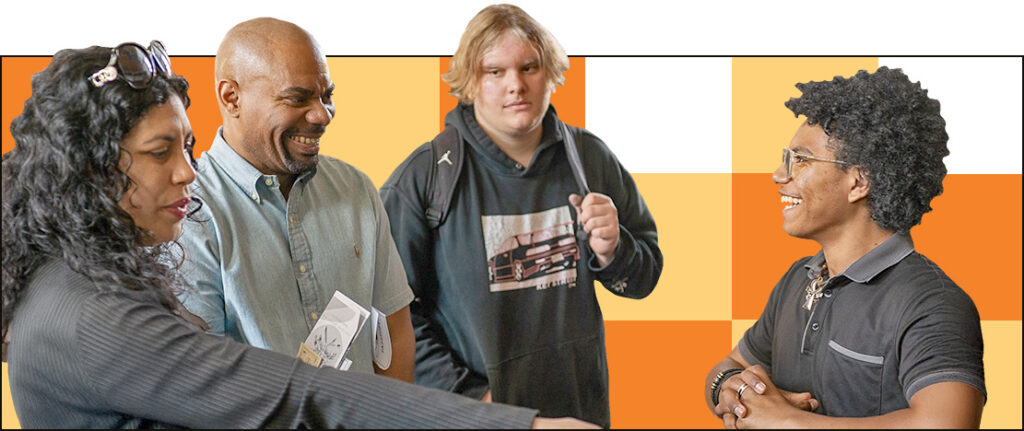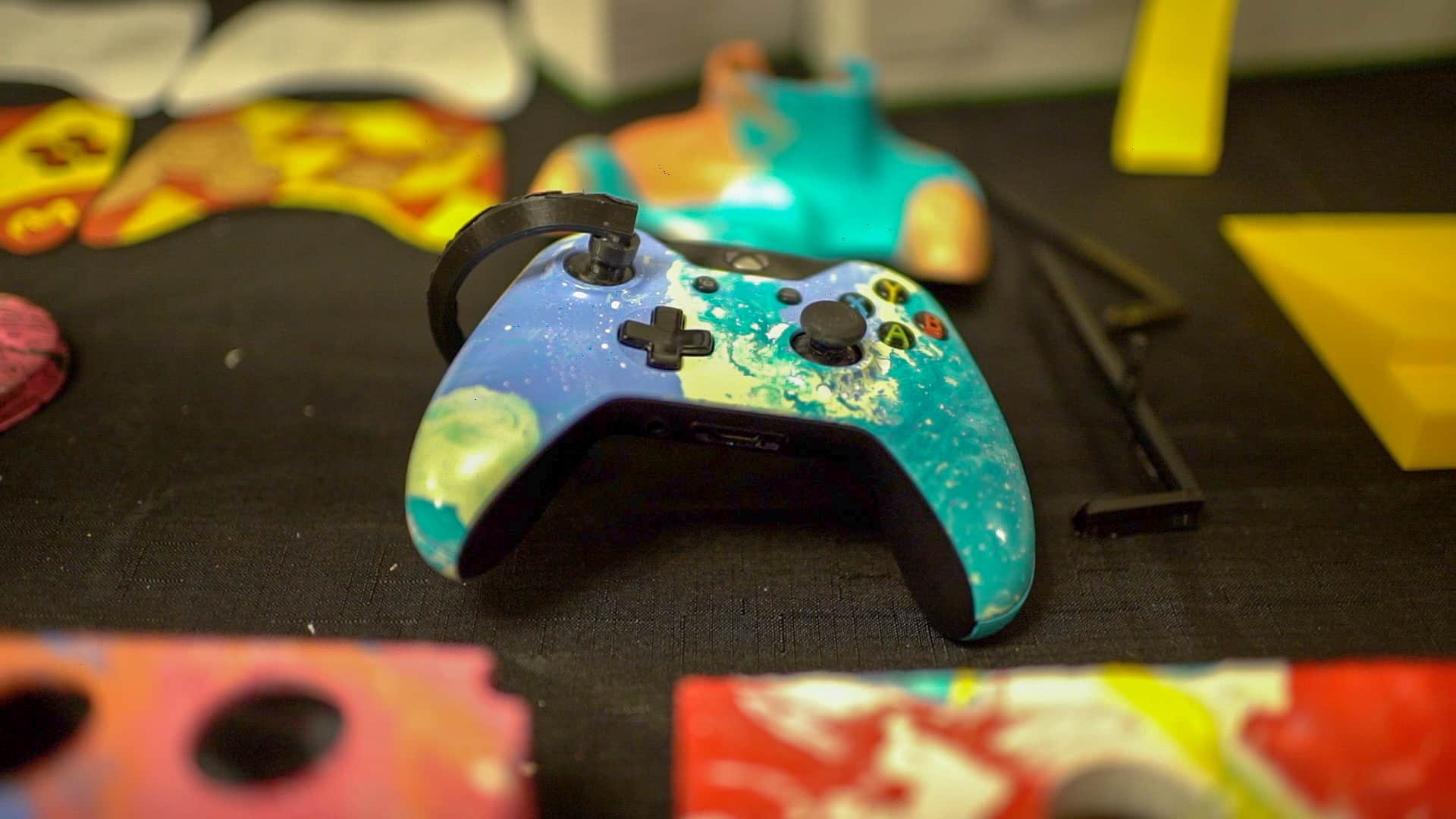


learn more about

learn more about

overview
partner with us
partner with us
events

events



learn more about

learn more about











Teachers Corey Clark, Curtis Taylor & Matt Gottilla designed the AbleGamerz Project, in which students designed and built adaptive video game controllers for clients with a variety of disabilities.
This interview was originally published as an episode of High Tech High Unboxed. It includes interviews with the three designing teachers, as well as students Emma L, Alex, and Emma P.
What is the story of this project?
Not everyone can use normal controllers. Because if you have a disability like muscular dystrophy, and you keep on losing strength in certain areas, then a normal controller just wouldn’t work for you. Because maybe you have to put certain pressure on a button, or you can’t reach that button.
AbleGamerz was making custom controllers for people with disabilities, so that way they could play video games. Because we all love video games. And why not include them in the great experience that we have?
Yes, there’s video games and technology and all of these pieces swirling around us. But ultimately, this is a project about access—who has it, who doesn’t, and how are we going to be the type of people who engineer a solution to that?
How did you and your teaching partners start this project almost three years ago now?
I’m a big supporter of backwards design. I think a good project always starts with what the product or the client or the end goal is, and works backwards and finds its curriculum that way. However, I felt this one was almost cyclical in nature. Meaning that not only did it start with our clients—Guillermo, Shane, Lucas, Ryan, Ronald McDonald House—these individuals are really at the heart of everything this project was. And through the exhibition, and the final product came back to them again.
What was the best part of doing this project?
I think the best part about the project was knowing that we built something that can help someone actually play video games. It was really cool. And I was really happy to see someone else that can’t really do something that I can, but just in a different way.
Just knowing that this is going somewhere for someone and it means something, you’re inviting them to a world of video games, and you’re letting them play. Because they’re going to play video games just like you, but they’re just doing it differently.
And it’s the professional quality work. It’s like the drafts kept on coming. You already knew the first drafts was going to have so many errors. And then you would have to redo it and fix it again.
It felt really cool, because it looks like an actual controller, like something that you would see in a store that actual people would buy.
Tell me about the person you met and designed for.
The controller that we made is for a person named Shane. He was in the military. And he had an accident. He lost his hand and his knee down. So he can’t pull the two triggers on the standard controller. We rewired it to where it’s these two now buttons. So now he can play one-handed.
What is the difference between designing for a single person versus a general design?
When you’re designing for individual clients, there’s a couple pretty big differences between more of a generic build. The first one is just the magic of working with real people and having those connections for them—with your students, with your clients. I think not only is it more rewarding than just coming up with a general solution, but it’s just so much more real to them. Because like a lot of the students alluded to, we’re literally sending this to these people who need it versus we’re working on an abstract problem that we’re hoping to come up with a more general solution for.
And then in terms of designing, it does require a lot more thought. Because you need to not only coordinate schedules and find times to connect with the people that you are designing for, find times to have students connect with them, but also you need to build in the background so that students can build that empathy, can understand what they’re doing. So there are some more design considerations. But the rewards and the payoffs for creating a project like this are more than worth it.
So amazing. This, in some ways, is like the ultimate engineering challenge. Because any time you’re building adaptive equipment, for pretty much anything—but that industry, the reason why it can’t be an industry that is mass-produced—and this is something that I didn’t know going in. But I was privileged enough to learn it through the relationships that I formed.
Every disability affects every individual differently. So in the very first year, we had Guillermo and we had Lucas. Different ends of the spectrum in terms of one was about my students’ age, and the other one was closer to my age, who was in the hospital. But they both suffered from muscular dystrophy. But how it was affecting their body and which states they were in was completely different. So therefore, the controllers and the needs they needed could not be more different.
What were some highlights for you as a teacher?
When you start a project that is human-facing, that is all about individuals and their needs and real human beings and empathy—even though it seems like it might be daunting or a lot of work for a teacher, you’re going to realize that things like engagement from your students and buy-in and authenticity are going to be solved for you. Whereas normally you would have to try to create these things and try to find a way to engage them or force a buy-in or something like that, the second that these really are real human beings that kids are connecting with and that avenue exists, then what you start to see is a lot of the teaching job is done for us at that point. And we just become project managers.
We’re helping them when they get stuck. We’re suggesting things. But we actually don’t need to worry so much about some of the pedagogy pieces, because they start to solve themselves.
When you give kids authentic, meaningful work, a lot of the other things just fall into place. Start with either a client or a need. If you start with a client or need, it’s going to start to unlock a lot of those later pieces thinking about how are we going to invite kids into this community? How are we going to broaden our perspectives?
And a lot of that came through really thoughtfully chosen pieces of text, speakers, community partners. And I think a lot of that is just as essential as the engineering aspect. Because without that, I don’t think you would have a full grasp on what it is that the needs are.
What is some advice you would give to a teacher wanting to do this type of project?
Do it yourself first. Don’t try to teach kids how to make something that you’ve never made. Grab a coworker and a pizza and a weekend to do the project or the important parts of it yourself first. Because it will make a world of difference when you’re trying to lead your students. You’ll know what to look out for, what pitfalls there are. And it will just go much more smoothly.
I think any time that I’m talking to any teacher and we’re talking about project creation and project planning, I think dream big. I feel like a lot of times that sounds like a cheesy piece of advice. But I feel like some of
the best projects and the best ideas never got off the first stage, because it’s easier to execute on the what I’ve seen done before versus things that are definitely achievable and easy to see through once you get all the students excited about it and you start going step by step by step.
But I would say first is those wild ideas that you get in your head sometimes, and you’re just like, yeah, that’d be great—but I just don’t know how I would even go about that. Rather than immediately let that idea slip from yourself, hold yourself to that. And then immediately start seeking out other individuals. And start trying to figure out what would be step one if I was quote, unquote, “going to make this happen”? What would step one be? And I think once that ball—or that snowball starts rolling, you start to realize you know what? This actually can happen.
This is why this is not a simple solution for the industry. There is no way to just say, and then here’s a controller for people with disabilities or here’s a controller even for these different groups of disabilities. It is that personalized. But in terms of somebody who’s creating a project and bringing kids through engineering, it’s kind of like a dream, right? Because it is literally everything you preach to kids about recognizing a problem and brainstorming a solution.
What types of things can you expect when students engage in these types of projects?
When you step back and you let kids do them and allow kids to be creative and allow kids to be really critical thinkers and allow them to work together and figure out problems together—this is what my understanding of school should be.
One of the really powerful things about the iteration in the process is when you look at our first ideas and our first drafts, and then you have them next to our final product, it’s amazing to see the progress that they’ve made over the course of the project. So not only is it a really useful framework for students to use in problem-solving in general, and to sort of lift all students to a place where they’re able to meaningfully contribute to the project, but it’s also a really cool way to see that progress in a very visual way over the course of the project.
I do remember a part where we would film these videos and take pictures just to—and send them to our clients to tell them that, hey, we remember you, and look at what we’re doing. And when we would take these videos and we would walk around the classroom and show them what’s going on and the students would explain what they’re doing, it really made you feel—really reminded me that you have to work harder than you’re ever going to work, because it’s going to mean something. You have to put your all in it.
It has to look like something you would buy, something you would use, something that’s going to last, not something that’s just going to be used a couple of times. So I guess the fear part is just knowing this is actually going to be useful. It’s going to the outside world.

